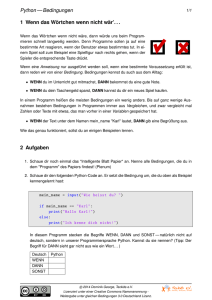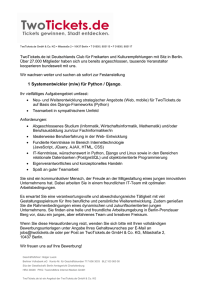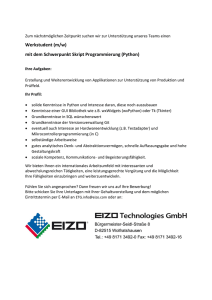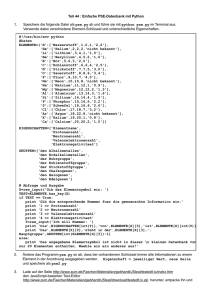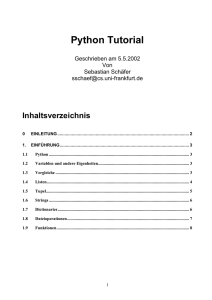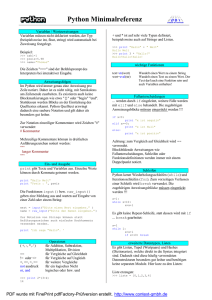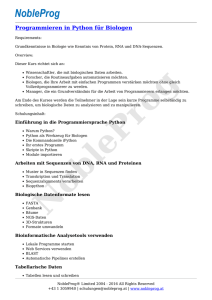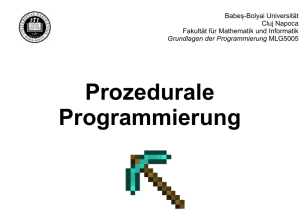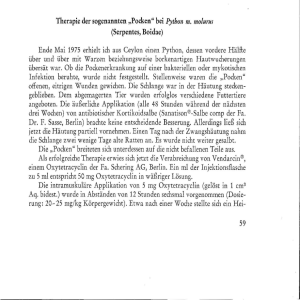Einführung und Grundlagen
Werbung
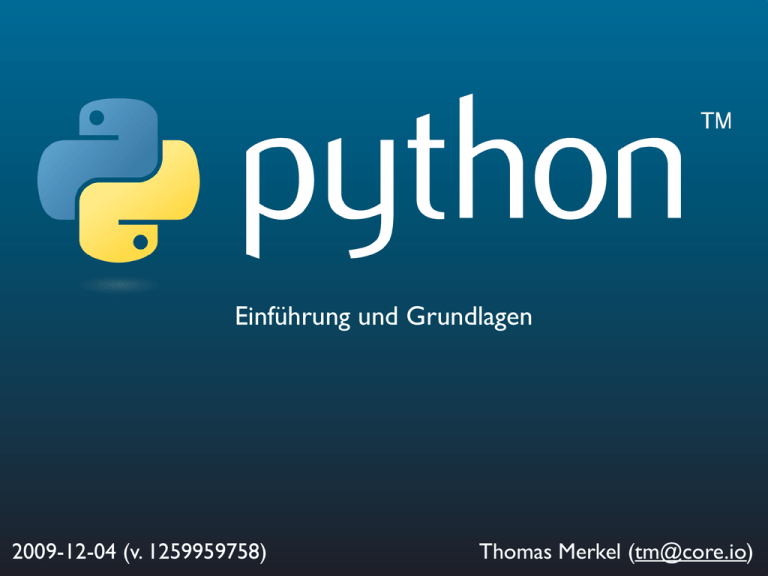
Einführung und Grundlagen 2009-12-04 (v. 1259959758) Thomas Merkel ([email protected]) Agenda • Warum Python? • Installation • Allgemeine Syntax • Datentypen: Zahlen, Bool, Strings • Listen, Tupel, List Comprehension, Slicing, Dictionaries • Code • Module,Verzweigungen, Schleifen, Funktionen 2 Warum Python? • Python ist ... • leicht zu erlernen • eine höhere Programmiersprache • frei verfügbar • durch viele verschiedene Bibliotheken erweiterbar 3 Paul Graham: The Python Paradox „I didn’t mean by this that Java programmers are dumb. I meant that Python programmers are smart.“ http://www.paulgraham.com/pypar.html 4 Installation • Windows • http://www.python.org/download/ • MSI Paket installieren, PATH wird automatisch gesetzt • Linux (Ubuntu) • aptitute install python2.6 • Tip: ipython 5 Allgemeine Syntax • Python ist casesensitv • Kommentare von „#“ bis Zeilenende • Blockbildung durch Einrücktiefe if x > 2: x += 3 # if-Block print x # if-Block beendet • Umlaute in Scripts # -*- coding: utf-8 -*6 Datentypen: Zahlen • Zahlen können „ganz“, „reell“ oder „komplex“ sein • +, • *, / • ** • // a = 1; b = 10 a = 1.0; b = 10.0 a = b = c = 2 a,b = 1,2.0 a,b = b,a 7 Datentypen: Bool • Booleans können „True“ oder „False“ sein. • Das Ergebnis logischer Operatoren ist ein Boolean. (==, !=, >, <, >=, <=, and, or, not) a = 1.0; b = 1; c = complex(1,0) a == b and b == c a == b == c d = -1 a == b > d 8 Datentypen: Strings • Strings werden zwischen ' ', " " oder """ """ geschrieben. s1 s2 s3 s3 = = = = 'a' "b" s1 + s2 s3*4 # ab # abababab s4 = """laengere Nachricht, ueber mehrere Zeilen""" 9 Listen, Tupel • Eine Liste wird mit eckigen Klammern umrahmt. • Ein Tupel wird mit runden Klammern umrahmt. • Listen darf man verändern, Tupel nicht. 10 Listen, Tupel x = [1, 2, 'ab', 3, 4] 'ab' in x # True x[0] = 11 # [11,2,'ab',3,4] 1 not in x # True del x[0] # [2,'ab',3,4] # Nicht möglich y = (1, 2, 'ab', 'c', 3, 4) y[0] = 11 11 List Comprehensions • Listen existierender Listen a = [2,1,3] b = [2*x for x in a] # b == [4,2,6] a = [2,1,3] b = [2*x for x in a if x < 3]! # b == [4,2] 12 Slicing • Elemente von Listen und Tupel werden mit einem Index von „0“ bis „n“ belegt. x = [1, 2, 3, 'a', 'b', 'c'] x[0] # 1 x[-1] # c x[1:3] = [11, 12] x[0:0] = [-3,-2,-1] x[0:0] = [[-3,-2,-1]] 13 Dictionaries (Hash Tables) • Dicts. bestehen aus einem Schlüssel und einem dazugehörigen Wert. • Dicts. sind nicht sortiert! a = {"gruen": 2, "rot": 1, "gelb": 2} a["gruen"] = 5! # Wert von "gruen" for name, num in a.items(): print "Name: %s Num: %s" % (name, num) 14 Code: Module • Bibliotheken werden mit „import“ geladen. • Mehrere Module gleichzeitig laden durch Kommas getrennt. # lädt alle Funktionen aus sys in # Namespace "sys" import sys import sys, os, re 15 Code:Verzweigung z = float(raw_input("Zahl eingeben ")) z1 = z % 2 if (z1 == 0): print("z ist eine gerade zahl") else: print("z ist keine gerade zahl") print z1 print z 16 Code: for-Schleifen zahlen = [1,2,3,4,5,6,7,8,9,10] summe = 0 for i in zahlen: summe = summe + i summe = 0 for i in range(1,11): summe = summe + i 17 Code: while-Schleifen i=1 summe = 0 while i <= 10: summe = summe + i i += 1 print "i: ", i else: print "Ende, Summe: ", summe 18 Code: Funktionen def meinesum(N=10): sum = 0 for i in range(1,N+1): sum = sum + i return sum meinesum() meinesum(5) meinesum(N=20) # 55 # 15 # 210 19 Eric Raymond „I was generating working code nearly as fast as I could type.“ http://www.linuxjournal.com/node/3882/print 20
